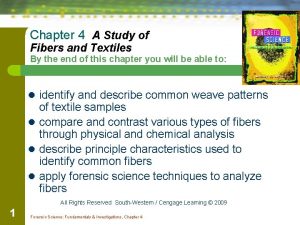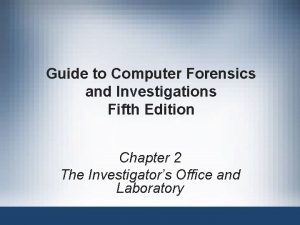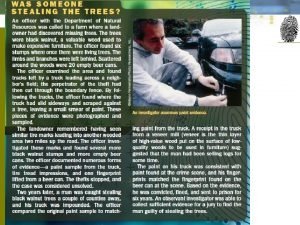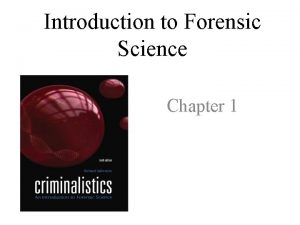1 Forensic Science Fundamentals Investigations 2 e Chapter



























- Slides: 27

1 Forensic Science: Fundamentals & Investigations, 2 e Chapter 3 All rights Reserved Cengage/NGL/South-Western © 2016

Chapter 3 Hair Analysis By the end of this chapter you will be able to: 3. 1 Identify the various parts of a hair. 3. 2 Describe variations in the structure of the medulla, cortex, and cuticle. 3. 3 Distinguish between human and nonhuman animal hair. 3. 4 Determine if two examples of hair are likely to be from the same person. 2 Forensic Science: Fundamentals & Investigations, 2 e Chapter 3 All rights Reserved Cengage/NGL/South-Western © 2016

Chapter 3 Hair Analysis By the end of this chapter you will be able to: 3. 5 Explain how hair can be used in a forensic investigation. 3. 6 Calculate the medullary index for a hair. 3. 7 Distinguish hairs from individuals belonging to broad racial categories. 3 Forensic Science: Fundamentals & Investigations, 2 e Chapter 3 All rights Reserved Cengage/NGL/South-Western © 2016

Chapter 3 Vocabulary o o o comparison microscope cortex cuticle gas chromatography hair follicle o o o 4 Forensic Science: Fundamentals & Investigations, 2 e Chapter 3 hair shaft keratin medulla melanin granules mitochondrial DNA (mt. DNA) nuclear DNA All rights Reserved Cengage/NGL/South-Western © 2016

Introduction o o 5 A hair without the follicle and its nuclear DNA cannot provide individual evidence. Hair can yield class evidence. Chemical tests performed on hair can reveal drugs, toxins, heavy metals and nutritional deficiencies. mt. DNA from hair can reveal some of a suspect’s or victim’s family relationships. Forensic Science: Fundamentals & Investigations, 2 e Chapter 3 All rights Reserved Cengage/NGL/South-Western © 2016

6 Forensic Science: Fundamentals & Investigations, 2 e Chapter 3 All rights Reserved Cengage/NGL/South-Western © 2016

History of Hair Analysis o 1883: Alfred Swaine Taylor and Thomas Stevenson covered hair in a forensic science text. o 1910: Victor Balthazard and Marcelle Lambert published a comprehensive study of hair. o 1934: Dr. Sydney Smith, analyzed hairs side by side using a comparison microscope. o Today: Standard procedures of hair analysis include microscopic examination and DNA analysis. 7 Forensic Science: Fundamentals & Investigations, 2 e Chapter 3 All rights Reserved Cengage/NGL/South-Western © 2016

The Functions of Hair o Regulates body temperature o Decreases friction o Protects against sunlight o o 8 Acts as a sense organ Humans are born with about 5 million hair follicles. Forensic Science: Fundamentals & Investigations, 2 e Chapter 3 All rights Reserved Cengage/NGL/South-Western © 2016

The Structure of Human Hair o Human hair consists of a root and a shaft that is in the follicle. Root 9 Forensic Science: Fundamentals & Investigations, 2 e Chapter 3 All rights Reserved Cengage/NGL/South-Western © 2016

The Structure of Human Hair (continued) o The hair shaft is made up of three layers: • • • 10 An inner medulla A cortex An outer cuticle Forensic Science: Fundamentals & Investigations, 2 e Chapter 3 All rights Reserved Cengage/NGL/South-Western © 2016

The Structure of Human Hair (continued) o 11 The cuticle is a transparent outer layer of the hair shaft. Forensic Science: Fundamentals & Investigations, 2 e Chapter 3 All rights Reserved Cengage/NGL/South-Western © 2016

Types of Medulla 12 Forensic Science: Fundamentals & Investigations, 2 e Chapter 3 All rights Reserved Cengage/NGL/South-Western © 2016

Types of Hair o o o 13 In humans, hair varies from person to person, and even varies depending on its location on a particular person. For an individual person, hair can vary based on its location on the body. To compensate for inconsistencies that occur, 50 hairs are usually collected from a suspect’s or victim’s head. Forensic Science: Fundamentals & Investigations, 2 e Chapter 3 All rights Reserved Cengage/NGL/South-Western © 2016

Hair Shapes o Can be straight, curly, or kinky, depending on the cross-section, which may be round, oval, or crescent-shaped. Round (Straight) 14 Oval (Curly) Forensic Science: Fundamentals & Investigations, 2 e Chapter 3 Crescent moon (Kinky) All rights Reserved Cengage/NGL/South-Western © 2016

Hair from Different Parts of the Body 15 Forensic Science: Fundamentals & Investigations, 2 e Chapter 3 All rights Reserved Cengage/NGL/South-Western © 2016

The Life Cycle of Hair – 3 Stages o Anagen stage; lasts approximately 3 -5 years - Asian o Catagen stage (resting stage) descent can last up to 7 years • Grows about 0. 4 mm per day, or 1 cm per month; approximately one-half inch per month • Average growth is 18 to 30 inches – up to 36 inches for Asian descent • o Telogen stage • 16 The hair stops growing and the follicle recedes – about 10 days The hair follicle is dormant and hair is easily lost – follicle is inactive for about 3 months - On average, 100 hairs are lost daily. Forensic Science: Fundamentals & Investigations, 2 e Chapter 3 All rights Reserved Cengage/NGL/South-Western © 2016

The 3 Stages of Hair Growth 17 Forensic Science: Fundamentals & Investigations, 2 e Chapter 3

Treated Hair o 18 Hair can be treated in many different ways. Forensic Science: Fundamentals & Investigations, 2 e Chapter 3 All rights Reserved Cengage/NGL/South-Western © 2016

Ethnic or Ancestral Differences o 19 There are some key physical characteristics that are associated with hair of different ancestral groups. Forensic Science: Fundamentals & Investigations, 2 e Chapter 3 All rights Reserved Cengage/NGL/South-Western © 2016

Animal hair and Human Hair o Animal hair and human hair have several differences including: • • • 20 The pattern of pigmentation The medullary index The cuticle type Forensic Science: Fundamentals & Investigations, 2 e Chapter 3 All rights Reserved Cengage/NGL/South-Western © 2016

Medulla Index To determine the medullary index divide the diameter of the medulla by the diameter of the hair o Medullary index for human hair is generally less than 1/3. o For animal hair, it is usually greater than 1/2. 21 Forensic Science: Fundamentals & Investigations, 2 e Chapter 3 All rights Reserved Cengage/NGL/South-Western © 2016

Medulla Index 22 Forensic Science: Fundamentals & Investigations, 2 e Chapter 3 All rights Reserved Cengage/NGL/South-Western © 2016

Hair Cuticles o 23 The cuticle of the hair shaft can help distinguish human hair from other animal hair. Forensic Science: Fundamentals & Investigations, 2 e Chapter 3 All rights Reserved Cengage/NGL/South-Western © 2016

Electron Microscopes o o 24 Electron microscopes direct a beam of electrons at a sample. Electron microscopes provide magnification of 50, 000 times or more. Forensic Science: Fundamentals & Investigations, 2 e Chapter 3 All rights Reserved Cengage/NGL/South-Western © 2016

Hair Examination and Testing o o o 25 DNA is extracted and amplified using PCR. DNA is profiled using an automated process. Mitochondria DNA (mt. DNA) can be used to establish a genetic relationship through the mother. Nuclear DNA is located in the root of the hair, not the shaft Suspects can be excluded if their mt. DNA is not consistent with the crime-scene mt. DNA. Forensic Science: Fundamentals & Investigations, 2 e Chapter 3 All rights Reserved Cengage/NGL/South-Western © 2016

Summary o o o 26 Hair is a form of evidence that has been used in forensic analysis since the late 19 th century. Hair is a characteristic shared by all mammals and functions in temperature regulation, reducing friction, protection from light, and as a sense organ. Hair consists of a follicle embedded in the skin that produces the shaft. Forensic Science: Fundamentals & Investigations, 2 e Chapter 3 All rights Reserved Cengage/NGL/South-Western © 2016

Summary (continued) o o o 27 The shaft is composed of the protein keratin and consists of the outer cuticle, a cortex, and an inner medulla, most of which can vary within and among individuals and among species. The shaft also has pigments and mitochondrial DNA. Hair varies in length, medulla type, and crosssectional shape, depending on where on the body it originates. Hair development is divided into three stages: anagen (growth), catagen (resting), and telogen (dormancy). Forensic Science: Fundamentals & Investigations, 2 e Chapter 3 All rights Reserved Cengage/NGL/South-Western © 2016
 Forensic science fundamentals and investigations chapter 6
Forensic science fundamentals and investigations chapter 6 Forensic pathologist vs forensic anthropologist
Forensic pathologist vs forensic anthropologist Forensic psychiatry vs forensic psychology
Forensic psychiatry vs forensic psychology Fundamentals of forensic dna typing
Fundamentals of forensic dna typing The golden book of camping
The golden book of camping What is nibis
What is nibis Chapter 14 forensic anthropology
Chapter 14 forensic anthropology Chapter 1 observation skills
Chapter 1 observation skills A study of fibers and textiles
A study of fibers and textiles Forensic science chapter 1
Forensic science chapter 1 Forensic science chapter 1
Forensic science chapter 1 Forensic science vocabulary
Forensic science vocabulary Forensic science chapter 1
Forensic science chapter 1 My favorite subject is...
My favorite subject is... Why aren t descriptive investigations repeatable
Why aren t descriptive investigations repeatable Year 6 maths investigations
Year 6 maths investigations Craigslist investigations
Craigslist investigations Marking bad clusters data hiding technique
Marking bad clusters data hiding technique Numerical datum crossword puzzle clue
Numerical datum crossword puzzle clue Statistical investigations examples
Statistical investigations examples Ohio bmv investigations
Ohio bmv investigations Conclusion for scientific method
Conclusion for scientific method Child protective investigations pasco county
Child protective investigations pasco county Chs investigations
Chs investigations Guide to computer forensics and investigations 5th edition
Guide to computer forensics and investigations 5th edition Right iliac fossa mass investigations
Right iliac fossa mass investigations Verifact investigations
Verifact investigations Antenatal investigations
Antenatal investigations


















































